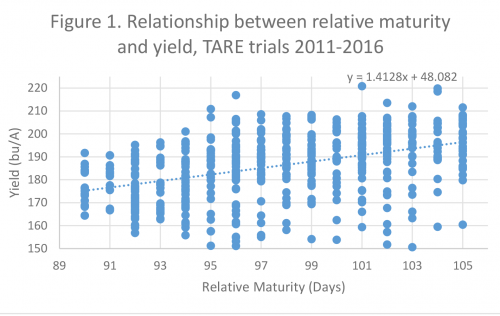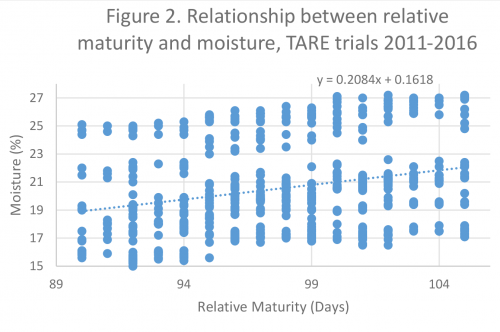Relative maturity and its relationship to yield and moisture – results from the Thumb
Data from several years of growing corn hybrids with varying relative maturities demonstrate the relationship between grain yields and grain moisture content.
Choosing corn hybrids is among the most important decisions a corn grower makes each year. Yield potential, disease resistance and herbicide/pest resistance are all important factors that need to be addressed and balanced. Another important factor is relative maturity. A full-season hybrid can take more advantage of available heat units, and yield more, everything else being equal.
Growers may choose hybrids of differing relative maturity for various reasons. Michigan State University Extension recommends choosing a hybrid that is likely to mature to black layer 10 days before the average first frost. You may also choose varying relative maturity to spread out flowering and pollination as a hedge against drought and to vary harvest dates. Usually, you do not choose all full-season hybrids because the summer may be particularly cool or a killing frost may arrive early.
As mentioned previously, a full-season hybrid can yield more than a short-season hybrid. However, there can also be a moisture penalty. The grain from later-maturing hybrids usually has a higher moisture content than short-season hybrids, again, everything else being equal.
MSU Extension Thumb Ag Research and Education (TARE) personnel established corn plots each year from 2011 to 2016. Participating seed companies were free to enter whichever hybrids they preferred to showcase within the range of 85-105 relative maturity. The hybrids were split into three maturity groups: 85–94 relative maturity, 95–99 relative maturity and 100–105 relative maturity. They were planted on five or six farms each year (five farms in 2011 and 2016, six farms 2012-2015) in Huron, Tuscola, Sanilac, St. Clair and Saginaw counties. Plots were in Saginaw County only in 2011 and in St. Clair County each year except 2011.
There were a few 85-89 relative maturity hybrids entered over the six-year period, but an individual relative maturity needed to be entered more than twice to be included in the analysis. Therefore, the range of hybrids used in this analysis was relative maturity 90-105. Table 1 shows the number of hybrids entered by year.
| Table 1. Hybrids entered by year | |
|---|---|
| Year | Hybrids entered |
| 2011 | 110 |
| 2012 | 120 |
| 2013 | 102 |
| 2014 | 83 |
| 2015 | 62 |
| 2016 | 61 |
The data in Figures 1 and 2 reflect the grain yields and grain moistures, respectively, when averaged across hybrids and years. Note that an individual relative maturity was not included in the data set if it had fewer than four entries over the six years. Hence, no hybrids with a relative maturity less than 89 are included in these data.

Figure 1. Relationship between relative maturity and yield, TARE trials 2011 – 2016.

Figure 2. Relationship between relative maturity and moisture, TARE trials 2011 – 2016.
There was, on average, a 1.4 bushel per acre increase in corn grain yield for an everyday increase in relative maturity. There was, on average, a 0.2 percent increase in grain moisture for an everyday increase in relative maturity.
At current corn prices ($3.50 per bushel with a $.050 basis), the extra 1.4 bushels per acre could gain an additional $4.20 per acre. However, that grain would, on average, have a higher moisture content.
What is the discount for growing wetter corn? According to the sources cited below, you can estimate high-temperature drying energy costs per bushel per point of moisture removed by multiplying the propane price per gallon ($1.29) by 0.022. That calculates as 2.8 cents per bushel per point. That extra 1.4 bushel will cost an additional 0.8 of a cent, more than covered by the increased yield.
These data suggest growers should grow the longest day hybrid that they feel comfortable growing in their area, keeping in mind there are good reasons for spreading out relative maturity. Also, there can be hybrids with shorter relative maturity that yield significantly better than longer day corn. Again, yield potential, disease package and genetic modifications are all important factors in hybrid choice, along with relative maturity.
This report was made possible by the generous support of the cooperating seed companies, and the Corn Marketing Program of Michigan.
More information
- Selecting corn hybrids for grain production by University of Minnesota Extension
- TARE Field Trial Results by MSU Extension
- Knowing cost of drying corn helps in marketing decisions by Southeast Farm Press



 Print
Print Email
Email


